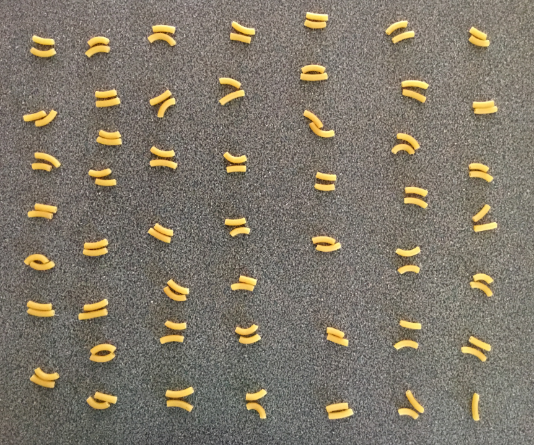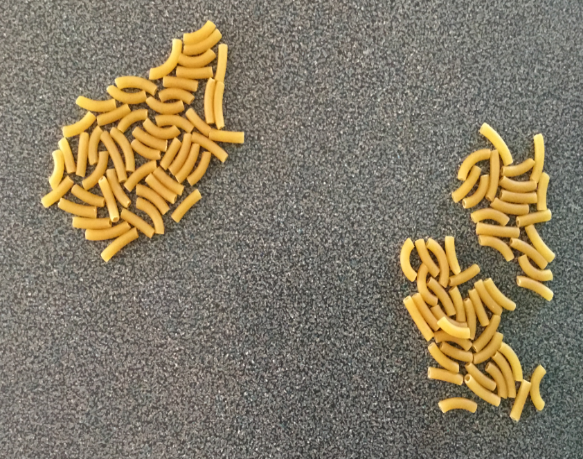Number: Margot’s macaroni
View Sequence overviewOrganising a collection into equal groups simplifies counting, as it removes the need to count each item individually.
Whole class
Margot's macaroni PowerPoint
Each group
Bag or tub of small macaroni pieces. Ensure the macaroni pieces are small enough for students to grab a handful containing 100 pieces.
Each student
Blank sheet of A4 paper to create a hand cut-out
Task
Show students slide 3 of Margot’s macaroni PowerPoint to introduce the context of the sequence, and describe your difficulty recreating Grandma Margot’s soup recipe. For example:
My grandma makes the best vegetable soup ever, and she gave me her recipe. It’s packed with vegetables and has macaroni in it—that’s what makes it so deliciously chunky! Last night, I tried making it for the first time, but it turned out nothing like Grandma Margot’s. It was watery and not chunky at all. I’m not sure what went wrong. The list of ingredients is here.
Read the list of ingredients focusing on the quantity of each ingredient. Explain to students that you followed the recipe exactly.
Ask: Can you help me? Why do you think my soup was less chunky than Grandma’s when I followed her recipe exactly?
Allow students to share their thinking, e.g. that the carrot was too little. Elicit responses until students suggest that ‘a handful of macaroni’ might have been the problem, or else suggest this yourself.
Pose the question: How can we quickly check how many macaroni pieces are in our handfuls to see if they are the same?
Storytelling

Using a story or anecdote at the launch of a task can hook students into a context where mathematics is relevant and meaningful. These stories may be real or fictional contexts that can be easily imagined by students. When stories reflect experiences that are familiar or accessible, they help students connect abstract mathematical concepts, structures, symbols, and representations to real-world applications.
In this scenario, the story is a fictional cultural narrative centred on one family. Grandma’s soup recipe is cherished, with macaroni an essential ingredient for making it chunky. While the difference between 89 and 100 pieces of macaroni would hardly matter in reality, it creates a context students can readily imagine and use as a springboard for mathematical investigation.
Stories are integral to many cultures and can be used to incorporate diverse cultural perspectives. For an example of how Mathematics as Storytelling (MAST) can embed Aboriginal and Torres Strait Islander perspectives in mathematics through symbolic representation, see Dr Chris Matthews’ work available on the QCAA website.
Using a story or anecdote at the launch of a task can hook students into a context where mathematics is relevant and meaningful. These stories may be real or fictional contexts that can be easily imagined by students. When stories reflect experiences that are familiar or accessible, they help students connect abstract mathematical concepts, structures, symbols, and representations to real-world applications.
In this scenario, the story is a fictional cultural narrative centred on one family. Grandma’s soup recipe is cherished, with macaroni an essential ingredient for making it chunky. While the difference between 89 and 100 pieces of macaroni would hardly matter in reality, it creates a context students can readily imagine and use as a springboard for mathematical investigation.
Stories are integral to many cultures and can be used to incorporate diverse cultural perspectives. For an example of how Mathematics as Storytelling (MAST) can embed Aboriginal and Torres Strait Islander perspectives in mathematics through symbolic representation, see Dr Chris Matthews’ work available on the QCAA website.
Provide students with access to a bag/tub of macaroni. Ask each student to grab a handful of macaroni from the bag/tub and count the number of pieces in their handful.
Provide students with time to start counting their handfuls. As students are working, ask them to pause and conduct a Checkpoint. This interruption is deliberate.
Checkpoint: What number are you up to in your counting?
Invite some students to explain strategies they are using (e.g. counting by 1s, 2s, or 5s) and discuss what makes a strategy both quick and accurate. Emphasise that grouping reduces counting and makes it easier to keep track of the count, making it efficient and accurate.
Prompt students to consider how they might structure their count without telling them directly.
Ask students to recount to check the accuracy of their total.
As students count their handfuls, observe the strategies they use and prompt reflection to support more efficient approaches. You might take photos of students’ counting strategies before and after the Checkpoint as evidence of how students’ thinking has shifted as a result of the class discussion.
Strategies you might observe with suggested prompting questions:
- No organisation – Students who do not arrange their macaroni may lose track, leading to missed or double counts. Prompt: How could you arrange the pasta so it’s easier to keep track?
- Counting by ones – Lining up pieces can support one-to-one correspondence. Notice whether students keep accurate track and use the correct number sequence. Prompt: What other ways could you arrange the pieces to help with counting?
- Creating groups – Some students may group by twos, fives, or tens.
- Are the groups equal in size? Prompt: How can you make sure each group has the same number?
- Are they using skip counting or still counting by ones? Prompt: How could the groups help you count more efficiently?
- Organised groups – Neatly arranged groups (e.g. in subitisable patterns) make it easier to see how many are in each group. If some pieces don’t fit into a group, prompt: What could you do with the extras that don’t fit into a group?
Checkpoint

Checkpoints are brief, purposeful pauses in an investigation when the teacher invites students to share their progress and challenges. These moments sustain momentum, promote reflection, and enable peer learning. By selecting groups to share, teachers can highlight a variety of approaches and guide the class toward deeper understanding.
In this lesson, the Checkpoint is intentionally used to move students from counting by ones to more efficient strategies. When interrupted, students will probably lose track of their count—an experience that exposes the limitations of one-by-one counting. This disruption creates space for the teacher to prompt alternatives such as grouping or skip counting. Experiencing the constraints of their initial method helps students recognise the value of structured strategies for keeping track and verifying their count.
Checkpoints are brief, purposeful pauses in an investigation when the teacher invites students to share their progress and challenges. These moments sustain momentum, promote reflection, and enable peer learning. By selecting groups to share, teachers can highlight a variety of approaches and guide the class toward deeper understanding.
In this lesson, the Checkpoint is intentionally used to move students from counting by ones to more efficient strategies. When interrupted, students will probably lose track of their count—an experience that exposes the limitations of one-by-one counting. This disruption creates space for the teacher to prompt alternatives such as grouping or skip counting. Experiencing the constraints of their initial method helps students recognise the value of structured strategies for keeping track and verifying their count.
Select some students to share their counting strategy with the class. Specifically focus on students who changed from counting in ones to using equal-sized groups.
Ask these students: What was the first counting strategy that you used? What was the second strategy that you used? Why did you choose to change your counting strategy after the class Checkpoint?
After selected students have shared, ask students to return to their macaroni to have a go at counting the macaroni using one or two of the different grouping strategies that were shared.
Provide students with a blank sheet of paper. Ask them to trace around their hand, cut it out, and record the total number of macaroni pieces in their handful in the centre of the cut-out.
Discuss as a class: Which strategy did you find most helpful for ‘quickly checking’ how many pieces of macaroni were in your handful? Why?
Focus the discussion on the idea that grouping strategies are more efficient than counting in ones.
Students may recognise that our hands are different sizes, or that some students may have grabbed a really big handful while others may not have filled their hand. Some students may have even used two hands.
Efficient strategies

By working with large collections, students have opportunities to try out and compare different counting strategies. This helps them recognise that some approaches are more reliable and manageable than others and supports the development of structured ways of grouping and tracking quantities.
Efficient strategies are those that require minimal effort, time, and complexity. In practice, efficiency usually comes from strategies that use fewer, more organised steps to reach a solution.
The Connect discussion helps students refine their thinking and recognise that strategies such as grouping in 2s, 5s, or 10s, are more efficient than counting by ones.
By working with large collections, students have opportunities to try out and compare different counting strategies. This helps them recognise that some approaches are more reliable and manageable than others and supports the development of structured ways of grouping and tracking quantities.
Efficient strategies are those that require minimal effort, time, and complexity. In practice, efficiency usually comes from strategies that use fewer, more organised steps to reach a solution.
The Connect discussion helps students refine their thinking and recognise that strategies such as grouping in 2s, 5s, or 10s, are more efficient than counting by ones.
Ask students to bring their hand cut-outs to the floor for the closing discussion.
Discuss how it is more efficient to count the macaroni pieces in our handfuls when they are organised into equal-sized groups.
Explain: When we organise the macaroni in our handfuls into equal groups, it’s easier to count because we don’t have to count every piece one by one.
Ask: We wanted to quickly check how many macaroni pieces were in our handfuls to see if they were the same. Were our handfuls all the same?
As a class, order the numbers on the hand cut-outs in ascending order and discuss the variation in handful sizes. Emphasise that the different size of each handful could explain why your version of Grandma Margot’s soup was less chunky.